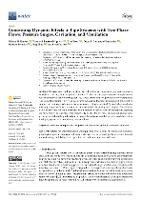Abstract
The risks associated with unsteady two-phase flows in pressurized pipe systems must be considered both in system design and operation. To this end, this paper summarizes experimental tests and numerical analyses that highlight key aspects of unsteady two-phase flows in water pipelines. The essential dynamics of air–water interactions in unvented lines are first considered, followed by a summary of how system dynamics change when air venting is provided. System behaviour during unsteady two-phase flows is shown to be counter-intuitive, surprising, and complex. The role of air valves as protection devices is considered as is the reasonableness of the usual assumptions regarding air valve behaviour. The paper then numerically clarifies the relevance of cavitation and air valve performance to both the predicted air exchanges through any installed air valves and their role in modifying system behaviour during unsteady flows














